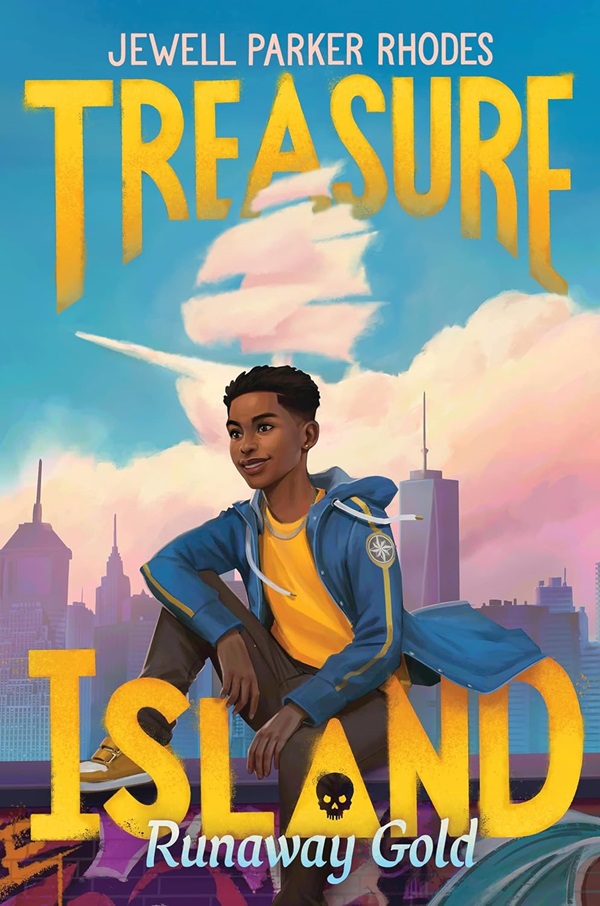
Reimagining Robert Louis Stevenson’s Treasure Island
Jewell Parker Rhodes has updated Stevenson’s classic in her new book Treasure Island: Runaway Gold.
 When I thought about writing an updated version of Robert Louis Stevenson’s novel Treasure Island (1883), my mind and heart were immediately engaged. As a professor, I’d taught Stevenson’s novels frequently and always marveled at the psychological complexity and moral ambiguity. Treasure Island, one of the first children’s books to feature pirates, included the rare instance of an adult betraying a child. Nonetheless, Stevenson’s novel created an enduring popular culture legacy of pirates as enticing characters that ignored their well-documented roles in the proliferation of colonization and the Transatlantic Slave Trade. The 1911 N. C. Wyeth illustrated American edition with its detailed drawings and brilliant colors, ensured Treasure Island’s enduring fame. Numerous television and film adaptations soon followed.
When I thought about writing an updated version of Robert Louis Stevenson’s novel Treasure Island (1883), my mind and heart were immediately engaged. As a professor, I’d taught Stevenson’s novels frequently and always marveled at the psychological complexity and moral ambiguity. Treasure Island, one of the first children’s books to feature pirates, included the rare instance of an adult betraying a child. Nonetheless, Stevenson’s novel created an enduring popular culture legacy of pirates as enticing characters that ignored their well-documented roles in the proliferation of colonization and the Transatlantic Slave Trade. The 1911 N. C. Wyeth illustrated American edition with its detailed drawings and brilliant colors, ensured Treasure Island’s enduring fame. Numerous television and film adaptations soon followed.
Reimagining Treasure Island for today’s youth, I wanted to deepen the exploration of class and race. Setting the novel in contemporary New York City provided the perfect opportunity to explore social inequities and to disband the original white cast (with its inference of white exceptionalism) and create a multi-ethnic world.
Zane, my protagonist, is African American. Like the original protagonist, Jim Hawkins, Zane’s father has recently died and he helps his mother earn income by renting to borders (including the mysterious Captain Maddie who receives the dreaded ‘black spot.’)
Instead of one central protagonist, I have three heroic kids. Kiko is mixed race (African-American and Japanese) whose father is a doctor and her mother, a professor. Kiko is the ‘brains’ of the trio as well as a kendo master. Jack is a low-income kid who tries to protect his mom and himself from his father’s bullying. These three life-long friends set out to solve seemingly impenetrable clues and locate the treasure. During the search, their perspectives and loyalty are challenged and tested. Each child’s ‘coming of age’ realistically includes heroism, bittersweet self-awareness, and life-defining choices. Hip-Hop, Zane’s loving Jack Russell, provides comic relief and protection (especially from rats!).
But how do urban kids sail? On skateboards, of course! During the pandemic, skateparks became a perfect metaphor for the camaraderie, derring-do, and resiliency of today’s youth.
My pirates use skateboards as sailboats, racing down streets and through abandoned underground subways to steal the treasure map. Zane, Kiko, and Jack, dodge the threatening crew and debate whether Captain John (a pirate or pretender?) can be trusted. Zane, desiring a father-figure, is the most vulnerable to Captain John and learns the hard lessons of John’s hypocrisy and shifting personas.
Setting the novel in New York also allowed me to memorialize African American history and the market where Black people were stood against a wall and sold. This wall inspired the famous and infamous name ‘Wall Street.’ To this day, very few people know that lower Manhattan was a profitable slave market and that thousands of Blacks built the port, banks, and office buildings of this world-famous economic centre.
Thomas Downing, a free Black and abolitionist known as the ‘Oyster King,’ used his Wall Street restaurant to cater to businessmen while also running an underground railroad station. Unlike Captain John who was deceptively ‘two-faced’ to steal treasure, Downing used his shifting personas to free oppressed people.
Searching for gold, Zane uncovers his heritage and discovers how the North did indeed enslave Black people and how his ancestors since colonial times, contributed significantly to the culture of New York. In 1991, while preparing construction for a federal office tower, human skeletons were found buried thirty feet beneath the surface. This led to the discovery of a six-acre cemetery for free and enslaved Blacks that had been built upon since the 1630s. Over 15,000 intact skeletal remains were uncovered. The last remaining quarter of the cemetery’s acres was spared and transformed into a national park site, The African American Burial Ground.
Sadder yet wiser, more aware of human dynamics, both psychological and emotional, Zane saves the treasure from pirates and donates the gold to preserve New York’s African American cultural heritage and the burial ground history.
I loved reimagining Treasure Island—combining my interests in history and literature with the exuberance of adventure tales. I hope all readers will cheer (and maybe weep a little) as Zane and his friends overcome treachery with allegiance, dishonesty with honesty, and betrayal with morality.
This novel is my praise-song to kids everywhere—each of you is a hero of your own life’s adventure. Set sail!
Dr. Jewell Parker Rhodes is an award-winning and New York Times bestselling author and educator for both youth and adults. She is the author of seven books for children including Ghost Boys and Black Brother, Black Brother, and the Louisiana Girls Trilogy: Ninth Ward, Sugar, and Bayou Magic. She is the Founding Artistic Director and Piper Endowed Chair at the Virginia G. Piper Center for Creative Writing at Arizona State University. She was awarded an Honorary Doctorate of Humane Letters from Carnegie-Mellon University.
Treasure Island: Runaway Gold is published by Quill Tree Books, 978-0062998354.




